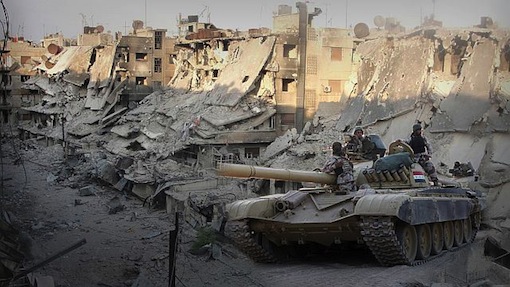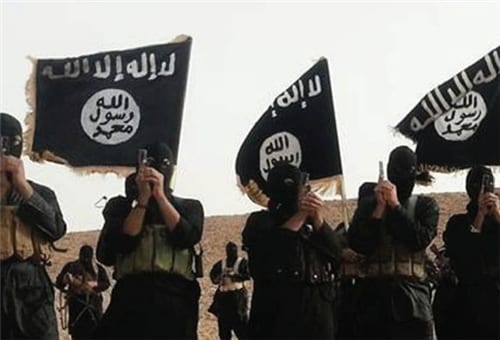
The American signature in Syria: reckless destruction everywhere.
In a recent Guardian article, (“Saudi Arabia says there is no future for Assad in Syria”) Saudi Foreign Minister Adel al-Jubeil is quoted saying, “This [the Syrian civil war] could be a more lengthy process and a more destructive process but the choice is entirely that of Bashar al-Assad.” The foreign minister did not specify how Assad would be forcibly removed, only that Saudi Arabia would tolerate nothing short of a complete regime change in Syria. Jubeil claimed that Saudi Arabia is backing ‘moderate rebels’ in the civil war.” The Saudis are indeed backing ‘moderate’ rebels — if the Nusra Front, an al-Qaida affiliate, is considered ‘moderate’.
Memories of Afghanistan still clearly in mind, Saudi Arabian officials are genuinely concerned about “blowback,” and for good reasons. A branch of Islamic State (aka: ISIS or ISIL) in Saudi Arabia has already carried out attacks in its northeastern, predominantly Shi’ite, province and against the Saudi government in others parts of the country. Saudi officials are well aware that Islamic State, with its roots in Saudi Wahhabism (an extreme form of fundamentalist Islam) the ruling family could come under attack, in part because of its close relationship to Washington and partly because of corruption at the highest levels of the Saudi government.
A February 2014 article by Reuters reported that Saudi Arabia had banned its citizens from fighting in ‘foreign wars’, promising 3-20 years imprisonment for violating this law. It also banned its citizens from sending material support, including funding, to certain Jihadi groups fighting in Syria. It cannot stop all private donations, often worth millions of dollars, from reaching the Islamic State and its affiliates, however. There are roundabout ways to get money to these groups, such as through Kuwait, that are difficult to track. Not only is Islamic State gaining territory in Syria and Iraq, it has thousands of supporters, many from outside the region.
[dropcap]I[/dropcap]t is still not entirely understood what attracts so many disaffected young people to leave their countries and take up the Islamic State cause. “Islamist fascism” as it has been called, may have its immediate roots in Wahhabism and Saudi Arabian influence across the Middle East and North Africa, but a full understanding of what brought it about must include an understanding of Western colonial and imperial history in the Middle East during the 20th and 21st centuries. There is no question, for example, that the US invasion of Iraq in 2003 played a major role in the creation of Islamic State and the sectarian warfare that is raging across much of the region today, particularly in Syria and Iraq; nevertheless, we would have to go back at least 200 years for an in-depth understanding of the role of outside powers in the creation (and destruction) of the modern Middle East.
After nearly six months of a brutal response by the Syrian military to non-violent protesters in Dera’a, Syria where protests for certain government reforms began in 2011, a number of people turned to armed conflict to fight the Assad regime. This opened the door for a host of competing outside proxies to arm and back a variety of different groups within Syria, upping the stakes of the war considerably. Saudi Arabia, Qatar, Turkey, and the U.S.- knowingly aided the rise of ISIS – albeit without fully understanding the monster they were creating.
For example, the United States has a long history of trying to topple the Ba’athist government in Syria, ruled by Hafez al-Assad for 40 years and now by his son, Bashar. A secret document leaked to the press by Wikileaks revealed that State Department and CIA officials sought to destabilize Syria for years, in part by stoking sectarian tensions between Sunni and Shi’a Muslims, and through support of dormant anti-regime Islamist factions already within the country, and Islamists who fled to Syria after the US ‘surge’ in Iraq in 2007 and its exit in 2011.

Bashar al Assad could have long ago simply escaped, as other rulers have when things got a bit hot for their comfort, leaving his nation to its fate at the mercy of Western “satraps”, but he has refused to abandon the struggle.
US officials now claim to be arming and training only ‘moderate’ rebels now – not understanding that many ‘moderates’ have defected to, or are fighting against and losing to, Islamic State and other extremist factions. This helps account for the flow of arms into Syria, and into the hands of IS members, radically changing the character of the war by turning it into an even bloodier catastrophe.
Ms. Loewenstein’s article continues after the editorial annotation below.
[box] [dropcap]T[/dropcap]he editors of The Greanville Post take exception to Jennifer Loewenstein’s assertion that “After nearly six months of a brutal response by the Syrian military to non-violent protesters in Dera’a, Syria where protests for certain government reforms began in 2011, a number of people turned to armed conflict to fight the Assad regime. This opened the door for a host of competing outside proxies to arm and back a variety of different groups within Syria, upping the stakes of the war considerably.”
This opinion is not supported by the evidence and facts. In a heavily referenced research article published in July 2015 in Global Reseach, “Daraa 2011: Syria’s Islamist Insurrection in Disguise”, Dr. Tim Anderson, an expert on the conflict lays out the evidence and facts to support the conclusion that from the very beginning, the protests were infiltrated by extremist Salafist Sunni Islamists and that the secular government of Bashar Assad was responding to the violence perpetrated by those sectarian Islamists. This article is very important, and we have republished it at The Greanville Post: https://www.greanvillepost.com/2015/10/06/daraa-2011-syrias-islamist-insurrection-in-disguise/
This flawed piece by Loewenstein is actually instructive for the anti-imperialist left. It demonstrates how a propaganda meme which serves the interests of U.S. imperialists is perpetrated (intentionally or not), not just in the mainstream media, but in alternative media in a leftist cloak. In fact, it is quite similar to the flawed propaganda meme of that malignant strain of the left, the imperialist left. The imperialist left also falsely demonizes Assad, claiming for example that the Syrian refugees are fleeing “Baathist terror” perpetrated by the Assad regime. Thus, the imperialist left also effectively supports U.S. imperialism in the Syrian conflict (as they have in several other conflicts, including Libya — and we see how the imperialist project there has turned out).
Here are a few pertinent quotes from Tim Anderson’s article:
“The Hama insurrection helps us understand the Daraa violence because, once again in 2011, we saw armed Islamists using rooftop sniping against police and government officials, drawing in the armed forces, only to cry ‘civilian massacre’ when they and their collaborators came under attack from the Army….
In the case of Daraa, and the attacks that moved to Homs and surrounding areas in April 2011, the clearly stated aim was once again to topple the secular or ‘infidel-Alawi’ regime. The front-line US collaborators were Saudi Arabia, Qatar and Turkey…
Saudi Arabia, a key US regional ally, had armed and funded extremist Salafist Sunni sects to move against the secular government…
In June, US Secretary of State Hilary Clinton dismissed the idea that ‘foreign instigators’ had been at work, saying that ‘the vast majority of casualties have been unarmed civilians’ (Clinton 2011). In fact, as Clinton knew very well, her Saudi Arabian allies had armed extremists from the very beginning. Her casualty assertion was also wrong. The United Nations (which would later abandon its body count) estimated from several sources that, by early 2012, there were more than 5,000 casualties, and that deaths in the first year of conflict included 478 police and 2,091 from the military and security forces (OHCHR 2012: 2; Narwani 2014). That is, more than half the casualties in the first year were those of the Syrian security forces. That independent calculation was not reflected in western media reports. ‘Watchdog’ NGOs such as Human Rights Watch, along with US columnists (e.g. Allaf 2012), continued to claim, well into 2012, that Syrian security forces had been massacring ‘unarmed protestors’, that the Syrian people ‘had no choice’ but to take up arms, and that this ‘protest movement’ had been ‘overwhelmingly peaceful until September 2011’ (HRW 2011a, HRW 2012). In fact, the political reform movement had been driven off the streets by Salafi-Islamist gunmen, over the course of March and April…”
Another major flaw in Loewenstein’s article centers around this passage: “Saudi Arabian and Iranian-backed factions are contributing to the proxy war in Syria, made the more complicated by Russian and US airstrikes across the country and the still greater issues of power and hegemony by these two historic adversaries. These airstrikes were supposed to represent a coordinated attack by Russia and the US against IS, but the US is claiming that Russia has attacked the US-backed ‘moderate’ rebel forces in an effort to bolster the Syrian regime, Russia’s first priority, while the US has been trying – and failing – to support those same forces in order to weaken Assad and IS simultaneously. US efforts have been a disastrous failure, even according to senior military personnel in Washington. This is a result, it would seem, of Obama’s having no real “policy” in the region to begin with. [And of not really targeting ISIL.—Eds] What can be surmised now is that Russian-US and Saudi-Iranian goals within an already tumultuous Syria may put the entire region on a collision course if there isn’t a more concerted effort to unify these and other proxy powers’ priorities soon. It is difficult to find a more cynical and deadly scenario in global politics today.”
Sometimes half-truths are more dangerous than overt lies because the half-truths are more difficult to spot. Or, a more charitable explanation might be that this is just extremely muddy thinking. At the very least, this “analysis” completely leaves out the issue of international law. The legitimate government of Syria, overwhelmingly supported by Syrians in that part of Syria not controlled by ISIS, has asked its allies for assistance in defending itself from the Takfiri malignancy funded and supported as a weapon against it by the U.S., Saudi Arabia, Turkey, Jordan, Qatar and Israel. The Syrian government has formally asked for Russia’s presence and military involvement, which is perfectly legal. Russia has been Syria’s long-standing ally. On the other hand, the U.S. presence in Syria is perfectly ILLEGAL — neither supported by a Syrian invitation or by a U.N. mandate. In typical liberaloid fashion, Loewenstein seems to want to (falsely) split the blame and promote a false equivalence: “Saudi Arabian and Iranian-backed factions are contributing to the proxy war in Syria…” Excuse me, but one of the most repressive and despicable tribes in human history, that great friend and ally of the U.S., Saudi Arabia, land of frequent public beheadings without a hint of due process, land where women are forbidden to drive, land of absolute monarchy and patriarchy based on a perverted interpretation of Islam, send their head-chopping and organ-eating Takfiri kindred spirits to topple the secular government in Syria in the service of their psychotic, bizarre sectarian religious beliefs, a perverted, cretinous offshoot of Sunni Islam, and in the service of their geopolitical control fantasies in the Middle East. (Apparently the imperialist left prefers this tribe over the secular government of Baathists…) Iranians, who have long suffered under the imperial yoke of Britain and the U.S., are helping Syria defend itself from this Takfiri terrorist malignancy. As is Hizbullah. All of these Syrian allies are acting in a most noble, inspired, MORAL manner, in complete, utter contradistinction to Saudi Arabia.
And, Ms. Loewenstein might come to appreciate, the situation regarding Russian and U.S. airstrikes is not complicated at all. Russia has effectively bombed ISIS. The U.S. has not (but elsewhere, it has excelled in bombing hospitals and wedding parties). In just a few days, using precision weapons, Russia has seriously degraded ISIS, allowing the Syrian Arab Army to mount effective ground operations. And you say, “…still greater issues of power and hegemony by these two historic adversaries…”? This is yet another false equivalence. Russia (and China) do not seek hegemony — they seek a multipolar world. It is the U.S. and its lapdogs that seek hegemony and unipolarity. It makes one wonder if Ms. Loewenstein has read Brzezinski’s “Grand Chessboard” or noticed how NATO bases have progressively ringed Russia since the “end” of the Cold War. “These airstrikes were supposed to represent a coordinated attack by Russia and the US against IS…”? Completely wrong. The U.S. had no interest in cooperating with Russia in a REAL attack against ISIS. Consider “How Russia Checked the US Plan for a No Fly Zone in Syria”, by Daniel Fielding, published in Russia Insider (http://russia-insider.com/en/military/how-russia-checked-us-plan-no-fly-zone-syria/ri10248):
“The reason for the presence of these air defence systems – the SU30 and SU34 aircraft, and the Moskva with its S300 missiles – is now clear. The article in the Financial Times I attach below confirms what many had already suspected: that the US was on the verge of declaring a no-fly zone over Syria. Though the supposed target was the Islamic State, since the Islamic State has no air force the actual target was clearly the Syrian government. It appears that a similar scenario to the one used in Libya in 2011 was being planned: the declaration of a no-fly zone, followed by a sustained bombing campaign against the Syrian army intended to deliver victory to the US backed Syrian opposition. The declared purpose of the no-fly zone – to fight the Islamic State – was merely cover. This explains the Russian deployment. The Russians obviously found out about the US plan, and rushed to carry out their own deployment in order to pre-empt it. That they were able to do so despite having – unlike the US – no air bases in the region is remarkable, and is further proof of the Russians’ repeatedly shown ability to act with lightning speed, catching the US off-balance. Previous occasions when this happened were the 2008 Georgia war and the 2014 Crimean operation. That the Russians found out about the US plan also shows how high the quality of their intelligence has become. The article in the Financial Times shows the extent of the dismay in Washington, with the grudging admission – despite the hysterical demands for action by the war hawks – that the plan for a no-fly zone “is now impossible to enact”… In other words the Russians have managed to deny the US access to the skies over Syria, thwarting their plan for a no-fly zone, and for a bombing campaign to force the overthrow of the Syrian government. The Financial Times quotes sources that describe the Russian deployment to Syria as a “disaster”, showing the dismay US and Western leaders feel. The Russian deployment to Syria has dramatically changed the geopolitical picture.”
And one of Russia’s priorities, which Ms. Loewenstein does not mention, is clearly to prevent the Takfiri malignancy (which the U.S. has produced in its imperialistic bungling — the root cause of the Taliban, al-Qaeda and ISIS) from infecting Russia and its Eurasian neighbors.
Finally, there will be no “unification” of priorities in the current circumstances, since the priority of the U.S. is (and always has been since the very birth of the Soviet Union) the destruction of Russia. Despite the bloviating of many (including the imperialist left and the anticommunist left), Russia is not imperialist. The priority of the U.S. and its western puppets is hegemonic unipolarity and imperialism, and this is precisely antithetical to the priority of Russia, China and the rest of the BRICS: a multipolar world (which offers the greatest chance of more equitable sharing of remaining resources).
—Daniel Wirt, Senior Editor
[/box]
ARTICLE BY MS. LOEWENSTEIN RESUMES HERE
Ironically, at the same time this tempest has engulfed parts of Syria and Iraq, rumors have been circulating that a high level Saudi prince has written a letter calling for ‘regime change’ in Riyadh, apparently supported by many in the royal family. Saudi Arabia’s own stability could conceivably be in question. The new Deputy Crown Prince, Muhammad (aka: “reckless”) bin Salman, a young, inexperienced leader has been made Defense Minister and is largely responsible for overseeing the terrible Saudi war in Yemen. According to a senior Saudi military officer who defected to Dhahran, many Saudis strongly oppose the war in Yemen and are appalled witnessing the most powerful Arab state in the region destroying the people and treasures of the poorest. Other rumblings of discontent with the current leadership by Saudi royals in the country have been noted as well. (“Saudi Royal calls for Regime Change in Riyadh”, the Guardian, 28 Sept.)
Hardline foreign policies advocated by the newly appointed Interior Minister, Muhammad bin Nayef, have been aimed primarily against Iran – seen as backing Houthi rebels in Yemen as well as pro-Assad forces in Syria. Saudi Arabian and Iranian-backed factions are contributing to the proxy war in Syria, made the more complicated by Russian and US airstrikes across the country and the still greater issues of power and hegemony by these two historic adversaries.
These airstrikes were supposed to represent a coordinated attack by Russia and the US against IS, but the US is claiming that Russia has attacked the US-backed ‘moderate’ rebel forces in an effort to bolster the Syrian regime, Russia’s first priority, while the US has been trying – and failing – to support those same forces in order to weaken Assad and IS simultaneously. US efforts have been a disastrous failure, even according to senior military personnel in Washington. This is a result, it would seem, of Obama’s having no real “policy” in the region to begin with. [And of not really targeting ISIL.—Eds] What can be surmised now is that Russian-US and Saudi-Iranian goals within an already tumultuous Syria may put the entire region on a collision course if there isn’t a more concerted effort to unify these and other proxy powers’ priorities soon. It is difficult to find a more cynical and deadly scenario in global politics today.
Note to Commenters
Due to severe hacking attacks in the recent past that brought our site down for up to 11 days with considerable loss of circulation, we exercise extreme caution in the comments we publish, as the comment box has been one of the main arteries to inject malicious code. Because of that comments may not appear immediately, but rest assured that if you are a legitimate commenter your opinion will be published within 24 hours. If your comment fails to appear, and you wish to reach us directly, send us a mail at: editor@greanvillepost.com
We apologize for this inconvenience.
![]() Nauseated by the
Nauseated by the
vile corporate media?
Had enough of their lies, escapism,
omissions and relentless manipulation?
Send a donation to
The Greanville Post–or
But be sure to support YOUR media.
If you don’t, who will?



